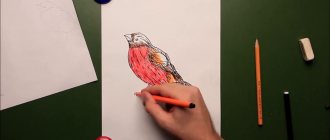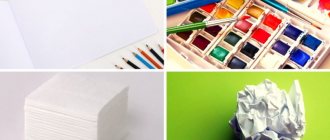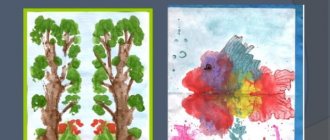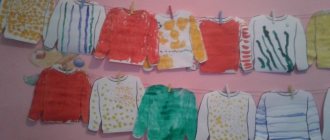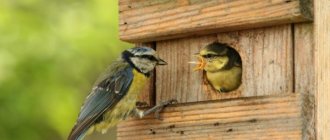Summary of a drawing lesson on the topic “Children doing exercises”
Lesson notes on the section “Artistic and aesthetic development” (drawing) for children with mental retardation in the senior and preparatory groups
on the topic: “Children doing exercises”
Educator: Mukhametdinova A.Ya.
Ufa-2018
Target:
Exercise children in drawing a human figure in motion.
Objectives:
• to consolidate the methods of making a sketch with a simple pencil and then coloring it in with colored pencils • to arouse interest in playing sports • to develop fine motor skills • to form in children the desire to complete the work started Handouts:
landscape
sheets, simple pencils, colored pencils, cards with drawn silhouettes people, counting sticks, a tablet, pictures of a person in different sports poses, a model of a human figure with moving limbs.
Progress of organized educational activities:
Educator:
- Guys! We have guests today. Say hello to them, smile at each other, at the guests, and wish everyone a good mood. Today we will listen, think and talk, play, draw. Let's take our seats.
Educator:
I want to tell an interesting tale about the stick man, he had a round head, and his torso, arms and legs were made of sticks. One day while playing, he fell and crumbled. He was so weak, he fell and immediately crumbled. Here you are so cheerful and strong, brave and dexterous. Tell me your secret, what helps you to be like this (children's answers)
Educator:
That's right, physical education, hardening, games for a walk, classes in the pool, etc.
Educator:
Guys, let's try to collect our stick men. We have a head, a torso, arms, legs. - Who will tell me what we will start with? (children's answers) That's right, let's start with the head. -Where should we place the head? (children's answers) That's right, at the top. -Where should we put the body? (children's answers) Right in the middle. -Where should we put our hands? (children's answers) Let's put our hands on the left and right. - Where will we place the legs? (children’s answers) That’s right, the legs are down. Well done.
Educator:
Let's repeat the exercise with our stick people to make them stronger. I will give everyone a drawing, and you repeat it with your stick people.
Children perform movements using figures.
Educator:
Stick men live not only in fairy tales, now I will show you where else stick men are used.
Showing traffic signs
Educator:
Who can tell me what these drawings are called? (Children's answers) That's right, these are traffic signs.
Educator:
Tired? Let's do some exercises.
Physical exercise “Smile”
Jerks up and down with our arms, as if we were waving flags. Let's stretch our shoulders. Hands move towards. Hands on hips. Smile. Lean left and right. Start squats. Don't rush, don't lag behind. And at the end - walking in place, One, two, three, four, five. We all had time to warm up and sat down again.
Educator:
Guys, we taught the stick men to do exercises, we did physical education ourselves. So that they remember these movements and do exercises every day, what can be done? (children's answers) That's right, draw.
- Let's repeat the body parts again, otherwise I already forgot (head, torso, neck, 2 arms, 2 legs)
- Where should we start drawing? (from the head)
— That’s right, if you can’t draw a circle evenly, you can use a stencil.
— What will we draw next (torso)
— What will we draw at the next stage? (arms and legs)
Educator:
What do you need to remember to ensure that the depicted figure turns out correct? (legs are the same length as the torso. Arms and legs are thinner than the torso. Arms reach the middle of the thighs and end with palms. Elbows are at waist level.
Educator:
Guys, what did you notice when you controlled the figures? What parts are movable (arms and legs consist of 2 parts, so they bend easily: arms at the elbows, legs at the knees)
Educator:
We start drawing first with a simple pencil, so that we can correct it, without pressing too hard with the pencil.
Educator:
Don’t forget to finish drawing the clothes, and on the head the eyes, nose, ears, and hair.
Educator:
Great, before we start drawing, we need to do some exercise for our eyes.
Gymnastics for the eyes “Be healthy”
(Children perform eye movements)
To make your eyes sharper, And so as not to walk around with glasses, I suggest repeating these necessary movements. Let's look at the distance and under the feet. Left, right quickly. Let's be surprised - what is it? And we will close them quickly. Open your eyes, now spin in a circle,
Educator:
Well done, we did some exercises for the eyes, now we can draw real athletes. Let each of you draw little people doing your favorite exercise.
Children draw on their own with simple pencils. Help for children (instructions, explanations, individual assistance)
Reflection:
— What new did you learn today?
— What was more difficult or easier to do?
-Where can you use this?
Lesson Objectives
When working with children, it is important to complete the tasks below. They can be divided into several groups
Developmental and educational
The following software tasks must be completed:
Children are taught to draw human figures, paying attention to the proportionality of various parts of the human body. Before drawing, they are taught to create a model of body position using stick figures. They tell you how to use it. Children are taught fine arts, the ability to express themselves in a drawing. They try to interest kids in playing sports, to show that it is useful and interesting.. FEMP classes in the 2nd junior group according to Pomoraeva and Pozina
FEMP classes in the 2nd junior group according to Pomoraeva and Pozina
They also face the following speech correction tasks:
- Using the example of physical exercises and the names of various parts of the body, children's vocabulary is developed.
- They teach kids the correct use of suffixes for diminutive names.
- The teacher, controlling sound pronunciation, teaches how to pronounce words correctly.
Note! Additionally, the problem of developing children’s fine motor skills is solved.
On the topic: methodological developments, presentations and notes
To consolidate children's knowledge about the troubles and grief brought by wars. To form patriotic feelings and interest in history.
To develop cooperation skills between children and parents; To involve parents in participating in the life of the group and kindergarten through the search and implementation of the most effective forms of work; To increase the level of parenting knowledge.
Summary of a drawing lesson in the senior group on the topic: “Children doing exercises.” Integration: “Communication”, “Physical education”, “Socialization” View.
Creating a collective plot composition, children learn to analyze the features of the image of a person in motion, correlate parts by size and proportions; develop skills in working with plasticine.
Source
What does morning exercise do for children?
Exercising in the morning has a beneficial effect on the functioning of the whole body. In the case of children, exercise or so-called gymnastics helps them wake up, strengthen their body, improve appetite, speed up metabolic processes, harmonize sleep and much more.
First of all, performing sports exercises instills in a child a desire for discipline and composure, which will be very useful to him in the future in adulthood.
- Moreover, it would seem that such a simple activity develops willpower in a little person, trains the spirit and increases endurance.
- Often, exercises for children are organized in kindergarten. There, trained specialists work with them, who are their educators or special trainers.
- Educators know which movements are suitable for exercise in young children and which are not. This is why the risk of injury is reduced to a minimum.
- However, not all parents send their children to kindergarten. And certainly not everyone adheres to the regime on weekends, when the child takes a break from visiting kindergarten.
- Unfortunately, parents find this activity boring, but what can we say about their kids? However, there is always a way out!
To make the process less boring, choose music to energize your children. Usually these are funny songs from good old Soviet cartoons or more modern melodies.
Music in the background will help your child understand the rhythm, and the lesson itself (even if it only lasts 15 minutes) will take place in a relaxed atmosphere.
Mandatory features of proper charging
So, what is it, correct charging? This concept includes several criteria:
- Gradual: under no circumstances force your child to start with something difficult. For example, do not immediately demand from him a perfect stretch so that when he bends over, he can rest his palms on the floor. The same can be said about the load. Increase it gradually, starting small. However, still do not rush. Before you is a growing, forming organism, work with which must be carried out with special care and caution.
- Systematicity: as in any other matter, regularity is important. That is, follow a specific exercise schedule. Ideally, children should study at the same time every morning. But here who has what opportunities.
- Variety: You should change the exercise program from time to time so that the child's muscles and body adapt to different types of exercise and new neural connections are formed in the brain. Use his favorite toys - do exercises with a ball, jump rope, etc. You can manage to come up with what words you say and what words the child says while doing exercises for children. This will stir up interest and contribute to a fun time.
- Moderation: Avoid overtiring your child. Better less and high quality than fast and nothing at all.
- Accessibility: Remember, this is a small child. You don't need complicated curtsies and plie squats. Simple stretches, turns, bends, squats and jumps are enough.
Kinds
There are several types of charging. Its variety helps to change the type of activity to another and give the child a break if he is tired of one or another exercise or is still finding it difficult.
Fun exercise for children
This activity takes the form of a game and is ideal for children from two to three years old. This age is ideal to start introducing them to sports. At this time, children are extremely restless, so why not channel their energy in the right direction? Moreover, everyone loves games, and they help develop ingenuity and an analytical mind.
Warm-up exercises
This type of sports activity does not mean a full-fledged workout, but a short warm-up, which perfectly helps to cheer up, recover from sleep and tune in for the coming day.
Power charging
Yes, no matter how paradoxical it may sound, children also need to be given a certain load in order to develop their muscles and endurance. The main purpose of this type of exercise is to use certain muscle groups during exercise.
In the case of children, strength exercises include running, lifting toys, jumping, and so on.

